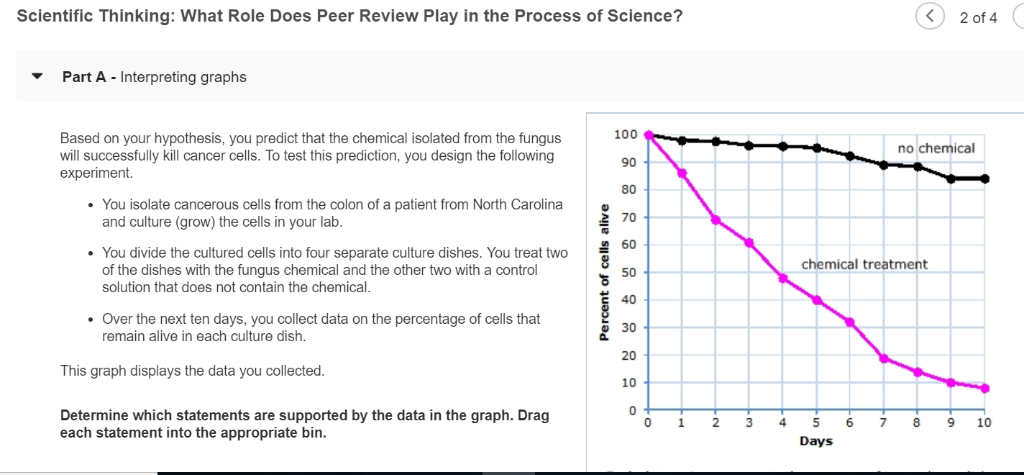Scientific Thinking: What Role Does Peer Review Play in the Process of Science? 2 of 4 Part A - I...



Scientific Thinking: What Role Does Peer Review Play in the Process of Science? 2 of 4 Part A - Interpreting graphs 100 90 80 2 70 60 50 40 30 20 10 Based on your hypothesis, you predict that the chemical isolated from the fungus will successfully kill cancer cells. To test this prediction, you design the following experiment. no chemical You isolate cancerous cells from the colon of a patient from North Carolina and culture (grow) the cells in your lab You divide the cultured cells into four separate culture dishes. You treat two chemical treatment of the dishes with the fungus chemical and the other two with a control solution that does not contain the chemical Over the next ten days, you collect data on the percentage of cells that remain alive in each culture dish This graph displays the data you collected Determine which statements are supported by the data in the graph. Drag each statement into the appropriate bin 0 1 23 4 5 6 7 89 10 Days
CH 1. The Foundations of Biology 2 of 4 Scientific Thinking: What Role Does Peer Review Play in the Process of Science? Review Imagine that you are a scientist hard at work in a cancer research lab. You and many of your colleagues are hoping to discover new powerful drugs that could prevent deaths from cancer Your research team has observed that cancer cells have a lower survival rate when exposed to samples of a certain species of fungus. To study this further, your team isolated several chemicals from the fungus, including one known to affect cell metabolism. You hypothesize that it is that chemical that lowers the survival rate of cancer cells.
CH 1. The Foundations of Biology Scientific Thinking: What Role Does Peer Review Play in the Process of Science? 2 of 4 Reset Help Cancer cells treated with the chemical Cancer cells treated with the chemical have a lower survival rate than cells have a higher survival rate than cells This chemical will be useful for treating colon cancer, but not necessarily for other types of cancers. that are not treated. that are not treated After 5 days of chemical treatment less than 50% of the cancer cells are alive. After 10 days without chemical treatment, more than 90% of the cancer cells are alive. This chemical will be useful for treating all types of cancers. Statement(s)supported by the data Statement(s) NOT supported by the data
Solved
Biology
1 Answer
Shajib Tanvir

Login to view answer.